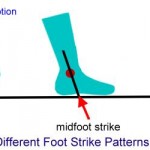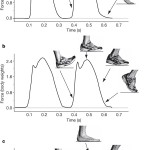Barefoot Running to Prevent Injury?
Barefoot. Minimalist. Maximalist. Heel strike. Midfoot strike. Forefoot strike. As a recreational runner, what do all of these buzzwords mean for you?
With yearly running injury rates at 24-56%1, there is a lot of interest in what is the best footwear and technique to prevent injury. The problem is that scientific evidence has yet to fully catch up to the hype.
Several studies have examined the dynamics of barefoot running vs shod running. Most consistently, it has been found that the barefoot condition leads to a reduction in stride length, a less dorsiflexed ankle at initial contact, and a shift from a rearfoot to midfoot or forefoot strike2. In English? You take shorter steps, you land with a flatter foot, and avoid landing on your heel.

(Image from: http://www.lifeofblyss.com/2012/05/how-i-kicked-the-shin-splints/)
Proponents of the barefoot movement advocate for mid-to-forefoot strike, since it may reduce impact load by avoiding the initial loading peak that occurs in most runners who heel strike3. It should be noted, that studies have found that heel-striking in shoes isn’t the same as heel-striking barefoot. Shoes with a cushioned midsole will decrease the magnitude of this vertical impact peak and will slow its rate3.

“a, RFS during barefoot heel–toe running; b, RFS during shod heel–toe running; c, FFS during barefoot toe–heel–toe running. Both RFS gaits generate an impact transient, but shoes slow the transient’s rate of loading and lower its magnitude. FFS generates no impact transient even in the barefoot condition”3
What’s more relevant to us however, is whether or not eliminating this initial impact peak leads to less injury? And unfortunately, there isn’t a good answer. A link between the presence or magnitude of an impact peak and increased risk of injury has not been consistently established in the literature. We do not have any controlled long term studies that conclusively show that barefoot or minimalist runners have reduced injury rates over traditional shoes.
So, if you’re comfortable, uninjured, and able to achieve your running goals in your current shoe, there isn’t a compelling reason to switch. However, if you are struggling with injury, your choice in shoes may have implications. For instance, if you are plagued by knee injury, studies show that barefoot running decreases the stress at the patellofemoral joint2.
However, before all of you with achey knees start throwing your shoes to the curb, it’s important to know that barefoot running requires increased work and stress on the ankle2. Your goal is not to trade your Patellofemoral Pain Syndrome for some Achilles Tendonitis! Such a change needs to be done gradually, and with care.
You should never make a sudden change of any sort in your running training. Your body needs time to adapt and muscles need time to strengthen! This is true with changing your running distance, speed, surface, terrain, technique, and especially shoes! Even if it’s a new pair of shoes of the same style. As tempting as it might be to showcase your fancy new kicks every where you go, use the following guide to make the transition to new shoes injury free.
Transition to New Shoes4 |
|
| First 2 Days | Walk at Home |
| Week 1 | Short Jogs |
| Week 2 | Intervals |
| Week 3 | Longer Jogs |
| Week 4 | Weekly Long Run |
Adapted from “Prevention of Running Injuries” from TheRunningClinic.ca
At the end of the day, while footwear is an important consideration, it’s not the only one. Many other factors play into injury risk, and changing your shoes will not correct muscle imbalances, nor allow you to progress your training more quickly than you should. Did you know that almost 80% of running injuries can be attributed to an increase in either running volume or intensity?4 For most people, this is where they should be placing their focus.
|
Practical Guide to Progressing Running4 |
| ✦ Increase in volume should not exceed 10% per week |
| ✦ The weekly long run should not exceed the long run of the previous week by more than 10-15 minutes |
| ✦ Increase in weekly intensity should not exceed 3% |
| ✦ In big training weeks, boost volume by adding a cross training activity such as cycling or aqua-jogging which are mechanically less stressful |
| ✦ Combine minutes of walking with running to reduce risk of injury |
| ✦ Be cautious and gradual when running on new surfaces, such as after then first snowfall |
| ✦ Choose a varied surface when possible |
| ✦ Quantify hill training by counting the number and length of hills, and progress cautiously |
Adapted from “Prevention of Running Injuries” from TheRunningClinic.ca
- Macera, C., et al. (1989). Predicting lower-extremity injuries among habitual runners. Archives of Internal Medicine, 149: 2565-2568.
- Bonacci, J., et al. (2013). Running in a minimalist and lightweight shoe is not the same as running barefoot: a biomechanical study. British Journal of Sports Medicine, 47: 387-392.
- Lieberman, D.E., et al. (2010). Foot strike patterns and collision forces in habitually barefoot versus shod runners. Nature, 463(7280): 531-353.
- Dubois, B. (2010). Prevention of Running Injuries. The Running Clinic.ca
